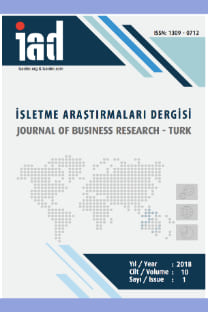Döviz Piyasa Oynaklığı İle Vadeli İşlem Piyasası Arasındaki Nedensellik İlişkisi
The Causal Relationship Between Exchange Market Volatility And The Futures Market
___
- Adrangi, B. ve Chatrath, A., (1998). “Futures Commitments And Exchange Rate Volatility. Journal of Business Finance And Accounting”, 25(3-4), 501-520.
- Baklacı. H.F. (2007)., “Türkiye’de Futures İşlemlerinin Spot Piyasa Oynaklığına Etkisi Üzerine Ampirik Bir Çalışma”, Zonguldak 11. Ulusal Finans Sempozyumu, 1-15.
- Bhargava, V. ve Malhotra, D.K., (2007). “The Relationship Between Futures Trading Activity and Exchange Rate Volatility. Revisited. Journal Of Multinational Management”, 17, 95-111.
- Bollerslev, T., (1986). “Generalised Autoregressive Conditional Heteroskedasticity. Journal of Econometrics”, 31, 307-327
- Bollerslev, T., (1987). “A Conditionally Heteroskedastic Time Series Model for Speculative Prices and Rates of Return. Review of Economics and Statistics”, 69, 542-547.
- Brooks, C., (2008). Introductory Econometrics for Financ, Cambridge University Press.
- Charemza, W.W. ve Deadman, D.F., (1993). New Directions in Econometric Practise England, Edward Elgar Publishing.
- Chatrath, A., Ramchander S. ve Song, F., (1996). “The Role of Futures Trading Activity in Exchange Rate Volatility”, The Journal of Futures Markets, 16(5), 561-584.
- Clifton, E.V., (1985). “The Currency Futures Market and Interbank Foreing Exchange Trading”, The Journal of Futures Markets, 5(3), 375-384.
- Crain, S.J. ve Lee, J.H., (1995). “Intraday Volatility in Interst Rate and Foreing Exchange Spot and Futures Markets”, The Journal of Futures Markets, 15(4), 395- 421.
- Çevik, E.İ. ve Pekkaya, M., (2007). “Spot Ve Vadeli İşlem Fiyatlarının Varyansları Arasındaki Nedensellik Testi”, Dokuz Eylül Üniversitesi İktisadi ve İdari Bilimler Fakültesi Dergisi, 22(2), 49-66.
- Dickey, D.A. ve Fuller, W.A., (1981). “Likelihood Ratio Statistics for Autoregressive Time Series With a Unit Root”, Econometrica, 49, 1057-1072.
- Enders, W., (1995). Applied Econometric Time Series, USA: John Wiley & Sons. Inc.
- Engle, R.F., (1982). “Autoregressive Conditional Heteroscedasticity with Estimates of the Variance of United Kingdom Inflation”, Econometrica, 50(4), 987-1007.
- Engle, R., (2001). “GARCH 101: The Use Of ARCH/GARCH Models in Applied Econometrics”, Journal of Economic Perspectives, 14(4), 157-168.
- Gökçe, A., (2001). “İstanbul Menkul Kıymatlar Borsası Getirilerindeki Volatilitenin ARCH Teknikleri ile Ölçülmesi”, Gazi Üniversitesi İktisadi ve İdari Bilimler Fakültesi Dergisi, 3(1), 1-24.
- Granger, C.W.J., (1988). “Some Recent Developments in a Concept of Causality”, Journal of Econometrics, 39(1-2), 199-211.
- Gujarati, D.N., (2001). Temel Ekonometri (Ü. Şenesen ve G.G. Şenesen çev.), İstanbul: Literatür Yayıncılık.
- Jochum, C. ve Kodres, L., (1998). Does The Introduction of Futures on Emerjing Market Currencies Destabilize The Underlying Currencies?, IMF Working Paper, WP/98/13.
- Johnston, K. ve Scott, E., (2000). “GARCH Models and The Stochastic Process Underlying Exchange Rate Price Changes” Journal of Financial and Strategic Decisions, 12(2), 13-24
- Kasman, A., Okan, B. Ve Torun, E., (2010). “Long Memory In Spot Market Volatility and Futures trading Volume: Evidence From The Turkish Stock Market”, International Journal of Statistics and Economics, 5(A10), 1-11.
- Kaziow, A. ve Arbaeus, S., (2007). The Relationship Between Currency Futures Trading Activity and Exchange Rate Volatility, (Master Thesis), Göteborg University. İsveç.
- Kızılsu, S.S., Aksoy, S. ve Kasap, R., (2001). “Bazı Makro Ekonomik Zaman Dizilerinde Değişen Varyanslılığın İncelemesi”, Gazi Üniversitesi İİBF Dergisi, 1-18.
- Kim, M. ve Min, B., (2008). “Derivatives Trading and Volatility in Foreign Exchange Markets”, Journal of Korea Trade, 12(1), 23-41.
- Nelson, N.B., (1991). “Conditional Heteroskedasticity in Asset Return: A new Approach”, Econometrica, 59, 347-370.
- Özden, Ü.H., (2008). “İMKB Bileşik 100 Endeksi Getiri Volatilitesinin Analizi”, İstanbul Ticaret Üniversitesi Sosyal Bilimler Dergisi, 7(13), 339-350.
- Özdemir, L., (2011). Vadeli İşlem Piyasası İle Spot Piyasa Oynaklığı Arasındaki İlişki: İzmir Vadeli İşlem Ve Opsiyon Borsası Üzerine Bir Uygulama, (Yayınlanmamış Doktora Tezi), Afyon Kocatepe Üniversitesi, Sosyal Bilimler Enstitüsü, Afyon.
- Perron, P., (1990). “Testing For A Unit Root in A Time Series With A Changing Mean”, Journal of Business and Economic Statistics, 8, 153-162.
- Ramanathan, R., (1998). Introductory Econometrics with Applications, USA: Harcourt Brace College Publishers.
- Zivot, E. ve Andrews, D.W.K., (1992). “Further Evidence on the Great Crash, thr OilPrice Shock and the Unit-Root Hypothesis”, Journal of Business & Economic Statistics, 10(3), 251-270.
- Vogelvang, B., (2005). Econometrics: Theory and applications with EViews, London: Pearson.
- ISSN: 1309-0712
- Yayın Aralığı: 4
- Başlangıç: 2009
- Yayıncı: Melih Topaloğlu
Su Kaynakları Yönetimi İçin Bir Öneri: Sistem Dinamiği
The Buffering Role of Social Support on the Relationship between Job Stress and Intention to Leave
HANİFE ÖZLEM SERTEL BERK, İLKNUR ÖZALP TÜRETGEN, Ece YETİŞEN SUN
Altın Piyasasında Asimetrik Oynaklık: Türkiye İçin Model Önerisi
ÇİĞDEM KURT CİHANGİR, ERGİNBAY UĞURLU
Hotel Businesses' Use of Social Media as a Public Relations Instrument: Twitter Sample
ERSİN ARIKAN, MEHMET KAHYAOĞLU, EMRE ÇİLESİZ
Kariyer Seçim Faktörleri ve Sektörün Bu Faktörleri Öğrencilere Sunma Düzeyine İlişkin Bir Araştırma
Müşteri Ara Yüz Özellikleri ile E-Bağlılık Arasındaki İlişkide E- Tatminin Aracılık Etkisi
